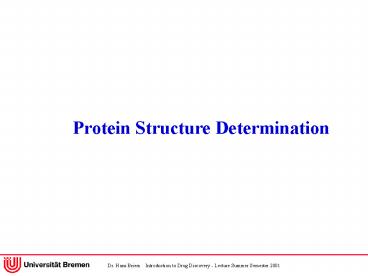Kein Folientitel - PowerPoint PPT Presentation
1 / 30
Title:
Kein Folientitel
Description:
Cryo-Electron Microscopy. Uses electron beams instead of xrays ... Cryo-Electron Microscopy. General structure of G-Protein coupled receptors: ... – PowerPoint PPT presentation
Number of Views:29
Avg rating:3.0/5.0
Title: Kein Folientitel
1
Protein Structure Determination
2
Drug Design Techniques
TARGET structure
- "Small molecule" Modelling
- Superimposition of known ligands
- Conformational analysis
- Pharmacophore hypotheses
- 3D-Database searches
- Structure-based Design
- Search for "hot spots"
- Pharmacophore hypotheses
- 3D-Database searches
- Docking
- De-novo Design
3
How to get 3D structures of proteins
- Experimentally
- Xray Crystallography
- Multidimensional NMR spectroscopy
- Cryo-Electron Microscopy
- Computationally
- Homology Modelling
4
Principle of Xray Crystallography
- Protein crystals are grown from aqueous solutions
by varying conditions - Temperature
- Salt concentration
- pH
- Crystals are placed into an intense Xray beam
- Xrays are scattered (diffracted) by electrons of
the protein - Diffraction pattern is collected
- Electron density is calculated by Fourier
transformation - 3D model is constructed and refined
5
Xray Crystallography Protein Crystals
6
Xray Crystallography Hardware
7
Xray Crystallography Diffraction
8
Xray Crystallography Diffraction
Diffraction only occurs when conditions of
Bragg's Law are obeyed
9
Xray Crystallography From Diffraction to
Electron Density Maps
10
Xray Crystallography From Density Maps to 3D
models
11
Xray Crystallography Resolution
gt Higher resolution of Xray diffraction yields
3D models of higher quality
12
Xray Crystallography Resolution
gtResolution can be increased by lowering the
temperature
13
Xray Crystallography Important terms
14
Xray Crystallography Example
15
Principle of Xray Crystallography
- Protein crystals are grown from aqueous solutions
by varying conditions - Crystals are placed into an intense Xray beam
- Xrays are scattered (diffracted) by electrons of
the protein - Diffraction pattern is collected
- Electron density is calculated by Fourier
transformation - 3D model is constructed and refined
- Structures of Protein-Ligand complexes can be
determined either by co-crystallisation or by
soaking
16
Principle of NMR Spectroscopy
- NMR spectrum of a protein is measured in solution
- Structural information is derived, based on
- Nuclear Overhauser Effect (NOE) -gt atom-atom
distances - J-Coupling constants -gt torsion angles
- From distance and angle constraints, a 3D model
can be calculated by Molecular Dynamics
simulations
17
NMR Spectroscopy Basics
18
NMR Spectroscopy Basics
- A second magnetic field is applied at varying
frequencies - Resonance absorbtion of nuclear spins can be
measured - Resonance absorbtion depends on atom type and
atomic environment ("chemical shift") - Resonance transfer across non-covalent atom
pairscan be measured ("Nuclear Overhauser
Effect")
19
NMR Spectroscopy Nuclear Overhauser Effect
Distances of non-covalent atomscan be measured
as cross-peaksin 2D NMR spectra Peak intensity
can be related todistance of the atom
pair Resulting NOE distances canbe applied as
constraints in Molecular Dynamics calculations
20
NMR Spectroscopy Example
21
Cryo-Electron Microscopy
- Uses electron beams instead of xrays
- Is well suited for structure determination of
2-dimensional crystals - Is currently the only technique to determine
high-resolution structures of transmembrane
proteins
22
Cryo-Electron Microscopy
23
Cryo-Electron Microscopy Example Frog Rhodopsin
24
(No Transcript)
25
Homology Modelling
- Goal Generation of a 3D protein model from
sequence only - Steps
- Find homologues proteins with known structures,
e.g. from PDB (www.rcsb.org/pdb) - Align sequences of structurally known proteins
- Find structurally conserved regions
- Align with target sequence (structurally unknown
protein) - Construct structurally conserved regions (SCRs)
- Construct structurally variable regions (SVRs)
- Run Molecular Dynamics simulation to refine model
26
Homology Modelling Sequence Alignment
27
(No Transcript)
28
(No Transcript)
29
(No Transcript)
30
Homology Modelling
- Summary
- Works well for sequences with high homology to
structurally known protein (gt30 identity) and
when several members of the family are known - Structurally variable regions ("loops") cause
problems when loops have different lengths - Correct prediction of amino acid sidechains can
be very difficult































